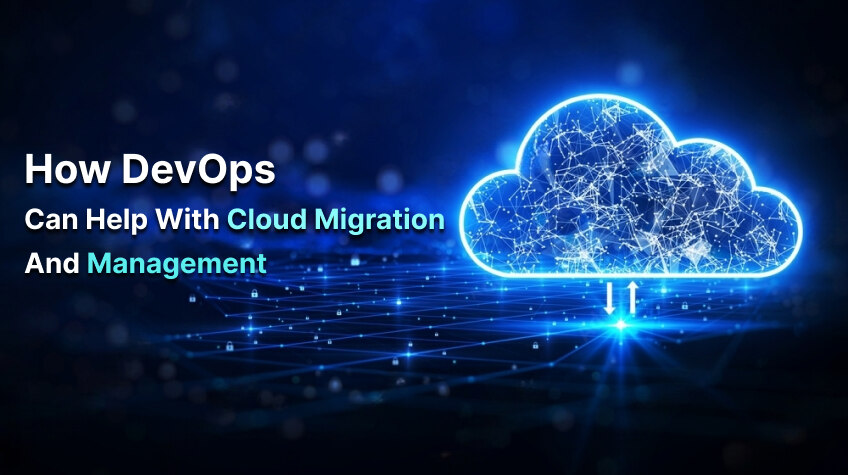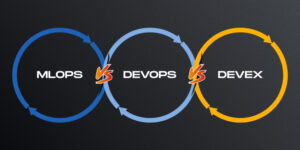
DevOps catalyze successful cloud migration and management, bridging the gap between operations and development. With its focus on automation, collaboration, and continuous improvement, DevOps practices facilitate a seamless transition to the cloud while ensuring efficient management of cloud-based applications. Organizations can streamline provisioning, configuration, and deployment processes by embracing automation tools and Infrastructure as Code principles.
Adopting CI/CD pipelines enables faster release cycles while monitoring and observability practices enhance performance optimization. DevOps’ emphasis on communication and collaboration fosters cross-functional alignment, leading to effective resource utilization and the integration of security and compliance measures. Through these initiatives, DevOps allows businesses to maximize the benefits of cloud technology. In this blog, we go through how DevOps can help with cloud migration and management.
What are the Benefits of Cloud Migration?
Cloud migration offers numerous advantages that revolutionize the way businesses operate. Firstly, it provides the following
- Unparalleled scalability.
- Allowing organizations to adjust their resources according to demand.
- Resulting in cost savings and increased efficiency.
Additionally, cloud migration eliminates the need for on-premises infrastructure maintenance, reducing operational complexities and freeing up valuable resources for core business activities. With improved accessibility, teams can collaborate seamlessly from any location, promoting productivity and agility. The cloud enhances data security with robust measures to protect sensitive information. Ultimately, cloud migration empowers businesses to embrace innovation, adapt swiftly to market changes, and focus on delivering exceptional products and services to their customers.
What are the Types of Cloud Models?
Cloud computing offers various models that cater to different business needs. Firstly, the public cloud model provides resources and services over the Internet, with infrastructure owned and managed by a third-party cloud provider. It offers flexibility, affordability, and ease of use, making it fit for new and small companies. While the private cloud model provides enhanced security and control, it is dedicated to a single organization. It is often preferred by industries with stringent compliance requirements.
Lastly, the hybrid cloud model combines both public and private clouds, allowing organizations to leverage both benefits while maintaining flexibility and data sovereignty. This model suits businesses with varying workload demands and specific data-handling needs.
Also Read: Impact of SAP Analytics Cloud (SAC) in Your Business Growth
Challenges in Cloud Migration
While cloud migration offers numerous benefits, it also shows challenges that institutions must steer. Data security and privacy concerns arise as sensitive data moves to the cloud. Ensuring robust security measures, compliance with regulations, and implementing strong access controls becomes crucial. Additionally, migrating existing applications and data to the cloud can be daunting, requiring careful planning, compatibility checks, and potential refactoring.
Cost management becomes critical, as organizations must accurately estimate and control expenses related to cloud services. Furthermore, dependency on reliable internet connectivity and potential vendor lock-in pose additional challenges. Addressing these challenges requires proper strategy, expertise, and meticulous execution.
Here are Several Ways DevOps Practices Can Help with Cloud Migration and Management
1. Automation
DevOps, emphasizing automation, empowers organizations to tackle cloud migration and management complexities efficiently by leveraging tools like Terraform, Ansible, and cloud-specific automation services. Processes such as provisioning, configuration management, deployment, and scaling become streamlined and accelerated. Automating this process reduces manual effort and reduces the risk of human errors, ensuring reliable and consistent environments.

Teams can focus on higher-value activities while repetitive and time-consuming tasks are automated, increasing productivity and faster time-to-market. Additionally, automation enables organizations to replicate and scale their cloud infrastructure as demand fluctuates quickly, optimizing resource utilization and improving overall performance.
2. Continuous Integration and Deployment (CI/CD)
DevOps’ adoption of continuous integration and deployment (CI/CD) practices is how organizations approach code deployments during cloud migration. Businesses can achieve frequent and reliable releases by automating build, test, and deployment processes, accelerating the migration timeline. CI/CD pipelines become the backbone of this approach, orchestrating the build, test, and deployment stages seamlessly in the cloud environment.
This automation ensures efficient and consistent deployments, eliminating manual errors and reducing the risk of configuration drift. With faster release cycles, organizations can rapidly iterate and respond to customer needs, fostering innovation and gaining a competitive edge. Ultimately, CI/CD practices enhance cloud migration projects’ overall efficiency and success.
3. Infrastructure as Code (IaC)
Infrastructure as Code (IaC) lies at the heart of DevOps practices, empowering organizations to manage their cloud infrastructure precisely. By adopting IaC principles, teams can define and provision their infrastructure through Code using tools like Terraform, AWS CloudFormation, or Azure Resource Manager templates. This approach offers numerous benefits, including repeatability, version control, and automation capabilities.
Infrastructure changes become predictable and reproducible, eliminating manual setup and configuration inconsistencies. Version control ensures accountability and collaboration, allowing teams to manage infrastructure changes. With IaC, organizations can efficiently create and manage cloud resources, reducing manual effort, promoting standardization, and ensuring consistent environments throughout the cloud migration and management lifecycle.
4. Monitoring and Observability
DevOps places significant emphasis on monitoring and observability to ensure the optimal performance of cloud-based applications. By implementing robust monitoring tools, log aggregators, and distributed tracing solutions, organizations can gain valuable insights into their applications and infrastructure performance.
These practices help identify performance bottlenecks, detect and diagnose issues, and optimize cloud resources for enhanced efficiency. With real-time monitoring and observability, teams can proactively respond to anomalies, rapidly troubleshoot problems, and ensure the reliability and scalability of their cloud environments. This proactive approach enables organizations to make informed decisions, optimize resource allocation, and deliver a seamless user experience while managing and scaling their cloud-based applications effectively.
5. Collaboration and Communication
DevOps, at its core, encourages collaboration and communication between different cloud migration and management teams. By breaking down silos that traditionally exist between the development and operations departments, there will be a seamless flow of information between them. Collaboration tools like chat platforms and project management systems facilitate efficient communication and coordination, allowing teams to share information, address challenges, and align their efforts toward a common goal.
This cross-functional collaboration enables early identification of potential issues and promotes a proactive approach to problem-solving. DevOps ensures that all stakeholders are involved by fostering a culture of collaboration and effective communication, resulting in faster decision-making, improved efficiency, and successful cloud migration and management endeavors.
6. Scalability and Flexibility
The scalability and flexibility cloud environments offer are amplified by adopting DevOps practices. DevOps enables organizations to seamlessly automate the provisioning and scaling of resources to meet varying demands. Cloud-based applications can dynamically adjust their resource allocation through autoscaling, load balancing, and elasticity, ensuring optimal performance and efficient resource utilization. This not only enhances cost efficiency but also improves the overall user experience.
By leveraging DevOps, organizations can effectively harness the scalability and flexibility of the cloud, adapting to changing workloads and user demands with ease. This agility empowers businesses to respond swiftly to market fluctuations, scale their operations, and deliver high-quality services while maximizing the benefits of cloud technology.
7. Security and Compliance
DevOps prioritizes security and compliance throughout the entire cloud migration and management journey. Organizations can proactively address security vulnerabilities and ensure secure configurations by integrating security measures into the development and deployment pipelines. Continuous security testing, vulnerability scanning, and automated compliance checks become inherent components of the DevOps workflow, enabling teams to identify and remediate issues early on.
Organizations can align with industry standards, regulations, and best practices by incorporating security and compliance into the DevOps process. This ensures data protection, mitigates risks and builds customer trust. DevOps’ focus on safety and compliance empowers businesses to navigate the complex landscape of cloud security effectively, fostering a secure and compliant environment for their cloud-based applications.
In conclusion, DevOps acts as a guiding force in cloud migration and management, enabling organizations to navigate the complexities and maximize the benefits of the cloud. By emphasizing automation, DevOps streamlines processes, reduces errors, and ensures consistent environments. Continuous integration and deployment practices enable faster and more reliable code deployments, expediting the migration journey.
Infrastructure as Code brings repeatability and automation, simplifying the provisioning and administration of cloud resources. With robust monitoring and observability, DevOps empowers proactive management and optimization of cloud-based applications.
Collaboration and communication bridge the gap between teams, fostering synergy and informed decision-making. DevOps also address security and compliance requirements, reinforcing trust in the cloud environment. With its holistic approach, DevOps unlocks the true potential of cloud migration, promoting efficiency, scalability, and innovation. We hope this blog on how DevOps can help with cloud migration and management is useful to the readers.






